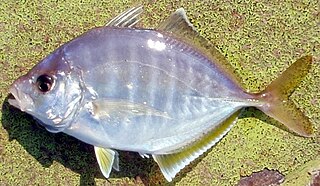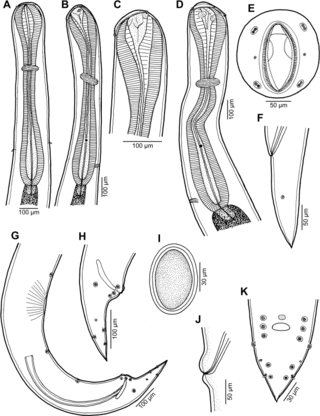Gnathostoma spinigerum is a parasitic nematode that causes gnathostomiasis in humans, also known as its clinical manifestations are creeping eruption, larva migrans, Yangtze edema, Choko-Fuschu Tua chid and wandering swelling. Gnathostomiasis in animals can be serious, and even fatal. The first described case of gnathostomiasis was in a young tiger that died in the London Zoo in 1835. The larval nematode is acquired by eating raw or undercooked fish and meat.

The brownspotted grouper, also known as the brown spotted reef cod, brown-spotted rockcod, coral grouper or honeycomb cod, is a species of marine ray-finned fish, a grouper from the subfamily Epinephelinae which is part of the family Serranidae, which also includes the anthias and sea basses. It has an Indo-Pacific distribution but in the northern Indian Ocean this distribution is discontinuous. It forms part of a species complex with two closely related species in the genus Epinephelus.

The whitefin trevally, also known as the horse trevally, is a species of deep water offshore fish in the jack family Carangidae. The species inhabits the tropical to temperate waters of the Indo-Pacific and central Pacific, ranging from South Africa in the west to Hawaii in the east. The whitefin trevally is a moderate-sized fish, growing to 37 cm, and is distinguished by a number of morphological traits, including fin size, gill raker count, and colour. It inhabits the continental shelf and slope at depths to 200 m over sand and mud substrates, where it preys on fish, crustaceans, and cephalopods. Studies in Japan indicate a length at sexual maturity of 17.4 cm on average, with spawning occurring between May and October, with each individual spawning multiple times. Whitefin trevallies are of high importance to fisheries in Japan, where they are taken by trawlers, although the catch numbers have halved since the 1980s. It is of minor importance elsewhere throughout its range, but is considered a good table fish.

The Trichosomoididae is a family of nematodes.

Setaria is a genus of parasitic roundworms that infect domesticated mammals such as pigs, camels, cattle and horses. Some species also infect wild mammals such as deer and antelope. The genus consists of about 43 species. Members of the genus are uniquely parasites in the abdominal cavity of the body. They are mostly large-sized roundworms, possessing an elaborate head (cephalic) region that is characterised by spines, presence of four lips, and well-guarded mouth. Little is known about their pathogenic effects, but some are known to affect nervous system and eye. The larval infective forms are transmitted from one animal to another by the bite of mosquitoes and flies. In addition Setaria marshalli can be transmitted from the womb to new-born calf.

Cucullanus is a genus of parasitic nematodes. The genus includes more than 100 species.

Camallanus is a genus of parasitic roundworms in the family Camallanidae.

Rasheedia is a genus of nematodes in the order Spirurida. The nematode genus BulbocephalusRasheed, 1966 was found to be a homonym of BulbocephalusWatson, 1916 and, therefore, a new name, Rasheedia n. nom., was proposed in 2018 to substitute it.

František Moravec is a Czech parasitologist who specialises on the Nematodes, especially the nematodes parasites of fishes. His research is mainly in the field of taxonomy of the Nematoda.

Cucullanus austropacificus is a species of parasitic nematodes. It is an endoparasite of the fish Conger cinereus. The species has been described in 2018 by František Moravec & Jean-Lou Justine from material collected off New Caledonia in the South Pacific Ocean.

Cucullanus gymnothoracis is a species of parasitic nematodes. It is an endoparasite of the lipspot moray Gymnothorax chilospilus. The species has been described in 2018 by František Moravec & Jean-Lou Justine from material collected off New Caledonia in the South Pacific Ocean.

Cucullanus incognitus is a species of parasitic nematodes. It is an endoparasite of the rare sparid fish Dentex fourmanoiri. The species has been described in 2018 by František Moravec & Jean-Lou Justine from material collected off New Caledonia in the South Pacific Ocean. Only female specimens were found.

Cucullanus epinepheli is a species of parasitic nematodes. It is an endoparasite of the brown spotted reef cod Epinephelus chlorostigma. The species has been described in 2018 by František Moravec & Jean-Lou Justine from material collected off New Caledonia in the South Pacific Ocean.
Terranova is a genus of parasitic nematodes. Species from this genus are known to parasitise sharks, rays, sawfishes, teleosts and crocodilians.

Cucullanus variolae is a species of parasitic nematodes. It is an endoparasite of the fish species Variola louti (type-host) and Variola albimarginata. The species has been described in 2020 by František Moravec & Jean-Lou Justine from material collected off New Caledonia in the South Pacific Ocean.

Cucullanus acutospiculatus is a species of parasitic nematodes. It is an endoparasite of a fish, the redbelly yellowtail fusilier, Caesio cuning. The species has been described in 2020 by František Moravec & Jean-Lou Justine from material collected off New Caledonia in the South Pacific Ocean.

Cucullanus diagrammae is a species of parasitic nematodes. It is an endoparasite of a fish, the Painted sweetlips Diagramma pictum. The species has been described in 2020 by František Moravec & Jean-Lou Justine from material collected off New Caledonia in the South Pacific Ocean.

Cucullanus parapercidis is a species of parasitic nematodes. It is an endoparasite of fish, the Yellowbar sandperch Parapercis xanthozona, which is the type-host, and the Speckled sandperch Parapercis hexophtalma. The species has been described in 2020 by František Moravec & Jean-Lou Justine from material collected off New Caledonia in the South Pacific Ocean.

Cucullanus petterae is a species of parasitic nematodes. It is an endoparasite of fish, the Honeycomb grouper Epinephelus merra, which is the type-host, and the Blacktip grouper Epinephelus fasciatus. The species has been described in 2020 by František Moravec & Jean-Lou Justine from material collected off New Caledonia in the South Pacific Ocean.

Ichthyofilaroides is a genus of parasitic nematodes, belonging to the family Guyanemidae Petter, 1974.


















